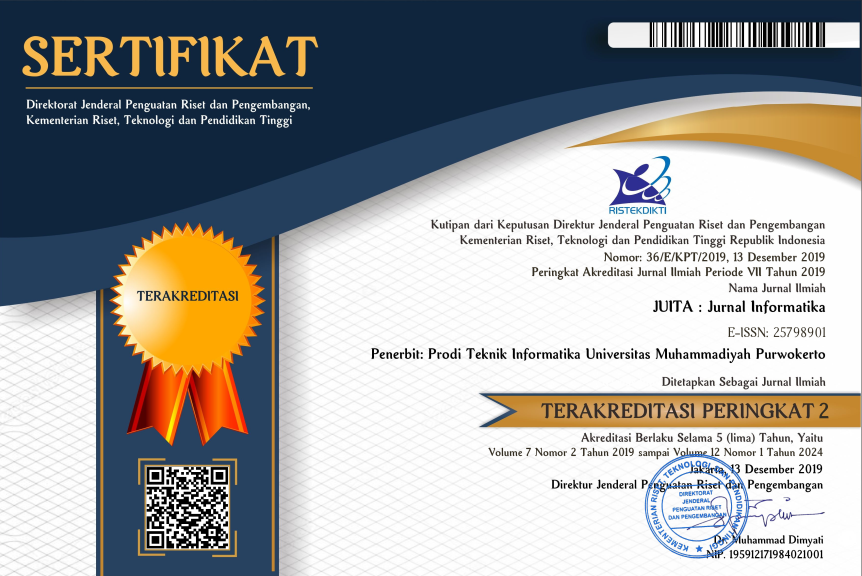Design of Networked Multiplayer Snake and Ladder Educational Game Based on Hash Map and Vector Data Structure
DOI:
https://doi.org/10.30595/juita.v8i2.8436Keywords:
Game, Moderator, Multiplayer, Network, ServerAbstract
Computer games have been used as educational media or popularly named as educational games. However, most educational computer games that have been created can be played by one player. This study aims to build a multiplayer ladder and snake educational game focused on the server program as a moderator that handles players, player groups, and data traffic during the game is running. The game is built on Java socket programming and local area network (LAN) as a data communication medium between players. Whereas to handle the username and socket address of the whole player, the hash map data structure is used. A vector data structure is also used to manage data package sending for each player group. The experiment shows that the system works properly where the computer server’s performance is influenced by the specifications, especially the processor and random-access memory (RAM).References
[1] G.-J. Hwang, L.-H. Yang, and S.-Y. Wang, “A concept map-embedded educational computer game for improving students’ learning performance in natural science courses,” Comput. Educ., vol. 69, pp. 121–130, Nov. 2013, doi: 10.1016/j.compedu.2013.07.008.
[2] Arbianingsih, Y. Rustina, T. Krianto, and D. Ayubi, “Developing a health education game for preschoolers: What should we consider?,” Enferm. Clínica, vol. 28, pp. 1–4, Feb. 2018, doi: 10.1016/S1130-8621(18)30025-1.
[3] M. Hartono, M. A. Candramata, K. N. Adhyatmoko, and B. Yulianto, “Math Education Game for primary school,” in 2016 International Conference on Information Management and Technology (ICIMTech), Bandung, Indonesia, Nov. 2016, pp. 93–96, doi: 10.1109/ICIMTech.2016.7930309.
[4] R. E. N. Arifah, S. Sukirman, and S. Sujalwo, “Pengembangan Game Edukasi Bilomatika untuk Meningkatkan Hasil Belajar Siswa pada Mata Pelajaran Matematika Kelas 1 SD,” J. Teknol. Inf. Dan Ilmu Komput., vol. 6, no. 6, p. 617, Dec. 2019, doi: 10.25126/jtiik.2019661310.
[5] G. Hookway, Q. Mehdi, T. Hartley, and N. Bassey, “Learning physics through computer games,” in Proceedings of CGAMES’2013 USA, Louisville, KY, Jul. 2013, pp. 119–126, doi: 10.1109/CGames.2013.6632617.
[6] S. L. Rahayu and F. Fujiati, “Penerapan Game Design Document dalam Perancangan Game Edukasi yang Interaktif untuk Menarik Minat Siswa dalam Belajar Bahasa Inggris,” J. Teknol. Inf. Dan Ilmu Komput., vol. 5, no. 3, p. 341, Aug. 2018, doi: 10.25126/jtiik.201853694.
[7] J. M. Rodríguez Corral, A. Civit Balcells, A. Morgado Estévez, G. Jiménez Moreno, and M. J. Ferreiro Ramos, “A game-based approach to the teaching of object-oriented programming languages,” Comput. Educ., vol. 73, pp. 83–92, Apr. 2014, doi: 10.1016/j.compedu.2013.12.013.
[8] D. Topalli and N. E. Cagiltay, “Improving programming skills in engineering education through problem-based game projects with Scratch,” Comput. Educ., vol. 120, pp. 64–74, May 2018, doi: 10.1016/j.compedu.2018.01.011.
[9] S. A. Pramuditya, M. S. Noto, and H. Purwono, “Desain Game Edukasi Berbasis Android pada Materi Logika Matematika,” JNPM J. Nas. Pendidik. Mat., vol. 2, no. 2, p. 165, Oct. 2018, doi: 10.33603/jnpm.v2i2.919.
[10] D. Damayanti, M. F. Akbar, and H. Sulistiani, “Game Edukasi Pengenalan Hewan Langka Berbasis Android Menggunakan Construct 2,” J. Teknol. Inf. Dan Ilmu Komput., vol. 7, no. 2, p. 275, Feb. 2020, doi: 10.25126/jtiik.2020721671.
[11] R. M. P. Siregar and E. Sudarmilah, “Rancang Bangun Virtual Reality Educational Game Penanggulangan Sampah berbasis Android untuk Anak Usia Sekolah Dasar,” JUITA J. Inform., vol. 7, no. 1, p. 49, May 2019, doi: 10.30595/juita.v7i1.4315.
[12] A. Yusnita and T. Rija’i, “Implementasi Algoritma Shuffle Random pada Pembelajaran Panca Indra Berbasis Android,” JUITA J. Inform., vol. 7, no. 1, p. 19, May 2019, doi: 10.30595/juita.v7i1.3647.
[13] K. Siu, M. Guzdial, and M. O. Riedl, “Evaluating singleplayer and multiplayer in human computation games,” in Proceedings of the International Conference on the Foundations of Digital Games - FDG ’17, Hyannis, Massachusetts, 2017, pp. 1–10, doi: 10.1145/3102071.3102077.
[14] E. B. Hurlock and R. M. Sijabat, Psikologi perkembangan: suatu pendekatan sepanjang rentang kehidupan. Erlangga, Jakarta, 1990.
[15] M. Fikri, “Rancang Bangun Aplikasi Game Battleship Multi Player Pada Jaringan LAN,” Thesis, Universitas Islam Negeri Sultan Syarief Kasim, Riau, 2013.
[16] M. Ika Wijayanti, “Perangkat Lunak Permainan Ular Tangga Multiplayer Berbasis Jaringan,” Thesis, Universitas Islam Negeri Sunan Kalijaga, Yogyakarta, 2013.
[17] M. F. Syahputra, R. F. Rahmat, and I. I. Aksa, “Perancangan Permainan Multiplayer Truf Gembira Berbasis Android,” Medan, Mar. 2013, vol. 1, p. 5, Accessed: Nov. 02, 2018. [Online]. Available: https://www.researchgate.net/publication/302896024_Perancangan_Permainan_Multiplayer_Truf_Gembira_Berbasis_Android.
[18] B. D. C. Putri, R. Kridalukmana, and E. D. Widianto, “Perancangan Aplikasi Permainan Multiplayer Gobak Sodor Berbasis Flash Di Lingkup Jaringan Lokal,” J. Teknol. Dan Sist. Komput., vol. 4, no. 2, p. 259, Apr. 2016, doi: 10.14710/jtsiskom.4.2.2016.259-265.
[19] A. J. Pratama, A. A. K. O. Sudana, and I. N. Piarsa, “Rancang Bangun Game Kartu Spirit Berbasis Android dengan Fitur Online Multiplayer,” Lontar Komput. J. Ilm. Teknol. Inf., pp. 49–60, 2015.
[20] A. Sivaraman, T. Mason, A. Panda, R. Netravali, and S. A. Kondaveeti, “Network architecture in the age of programmability,” ACM SIGCOMM Comput. Commun. Rev., vol. 50, no. 1, pp. 38–44, Mar. 2020, doi: 10.1145/3390251.3390257.
[21] G. He and L. Li, “Design and Realize Communication System Based on LAN of C/S Architecture,” in 2009 WRI World Congress on Software Engineering, Xiamen, China, 2009, pp. 78–81, doi: 10.1109/WCSE.2009.81.
Downloads
Published
How to Cite
Issue
Section
License

JUITA: Jurnal Informatika is licensed under a Creative Commons Attribution 4.0 International License.
















